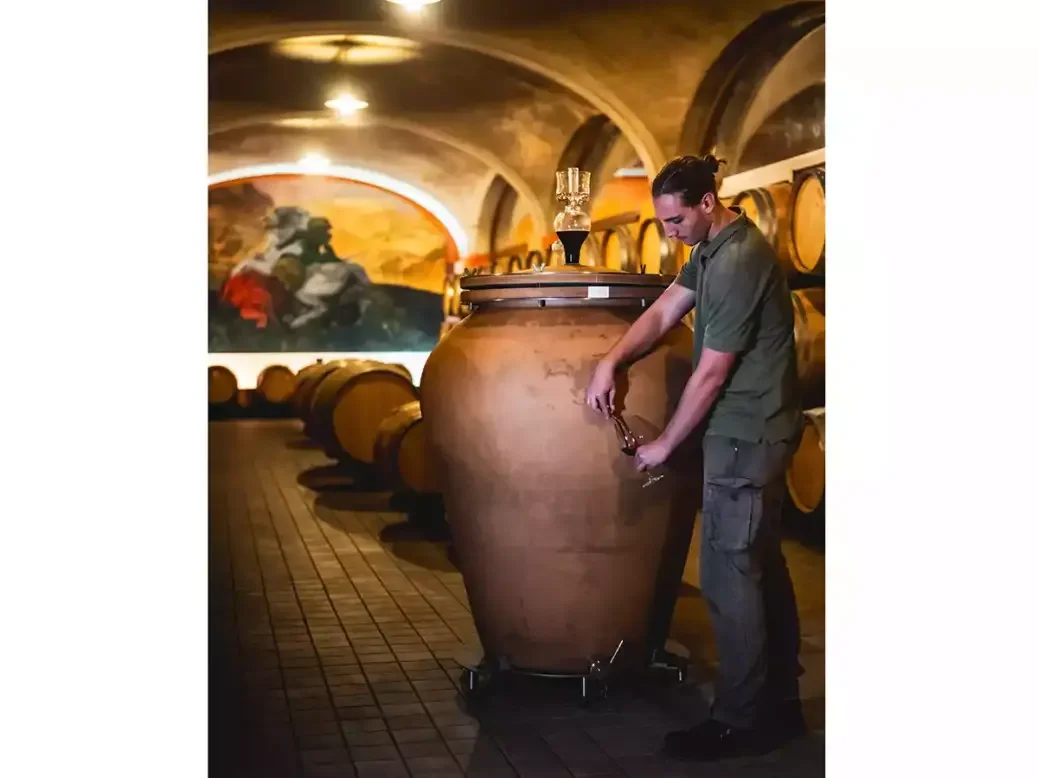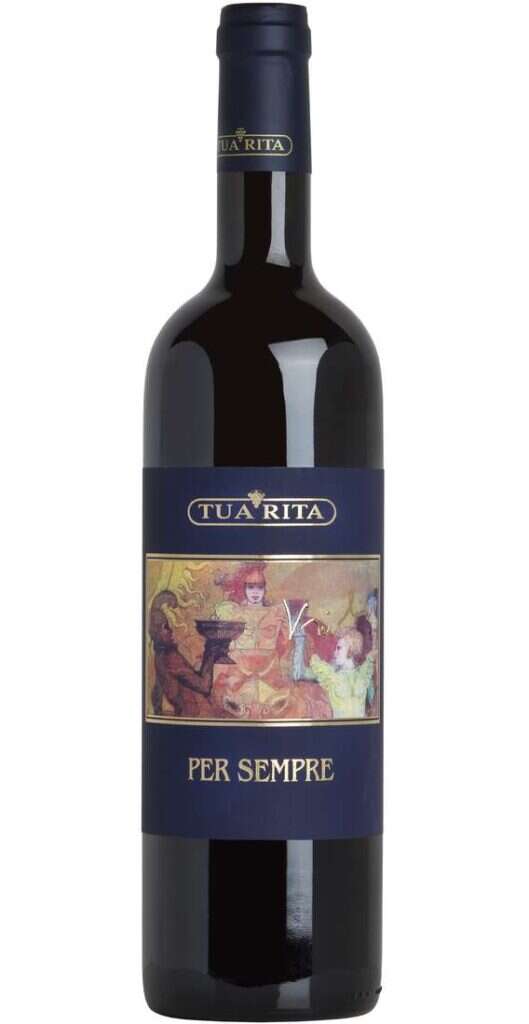
Tua Rita is a family-owned winery in the northern Maremma, near Livorno in Tuscany, just within view of the Tyrrhenian Sea, in the verdant Val di Cornia. Dark cypresses pierce the heavenly October-blue sky, rows of loaded fermentation vats stand sentinel, barrels from last year’s vintage gently exhale their angel’s share, frog-green oil spills out of the frantoio. This part of Tuscany is, of course, renowned for Super-Tuscans—the luxurious, barrique-aged Bordeaux blends that garnered worldwide acclaim in the 1990s and 2000s and now rival the best wines from Napa, Stellenbosch, and Coonawarra.
The Piombino Channel between Italy and the island of Elba funnels the mistral winds and shelters this section of the coast from storms. In the summer, it is up to 7°F (4°C) warmer here than in Bolgheri 25 miles (40km) to the north, where most of the other famous Super-Tuscans originate. The freshness of the wines is preserved by a high diurnal range, thanks to the Cornia River, which flows down to the sea from the Colline Metallifere, rich in manganese, iron, and other trace elements that constitute the soils here, as well as the rose-colored marble in the vineyards. Tua Rita ranges from 330ft to 1,250ft (100–380m) above sea level, and the clay and calcareous soils, which are drier and less fertile than in Bolgheri, give structure to the wines. When Tua Rita was first established, the vineyards were planted in wide rows, with tighter spacing between vines and a high density of up to 9,000 vines/ha; but now, with smaller tractors available, the newer vineyards are planted with climate change in mind, with narrower rows and wider spacing within the row and lower density overall, at 5,500 vines/ha. When these vineyards come into production, the estate will be better equipped to face drought years such as 2022 and 2020.
Tua Rita is named after the family matriarch, Rita Tua, but the estate is run and managed by her affable, hardworking son-in-law Stefano Frascolla. There is a daughter/wife in the middle, Simena Bisti, fleetingly espied at the estate decanting its just-pressed olive oil into spotless dishes to be mopped up with saltless bread. Starting with the first vintage of Giusto di Notri in 1992—a classic Bordeaux blend of Cabernet Sauvignon, Merlot, and Cabernet Franc—Tua Rita has been a fortuitous, long-term, though not continuous collaboration of the Tua-Bisti-Frascolla family and the consultant enologist Luca D’Attoma, still working with them today. As a graduate, D’Attoma was convinced of the great potential of Bordeaux grape varieties on this terroir. “I was young, I was idealistic; I wanted to do something important in a new place,” D’Attoma recalls. What started in 1984 as a modest country retreat with a 1ha (2.5-acre) parcel of Sangiovese for the family’s private consumption, today produces around 350,000 bottles a year from 71ha (175.5 acres)—most planted to the classic Bordeaux varieties (Cabernet Sauvignon, Merlot, and Cabernet Franc) but some to Syrah, Sangiovese, and Ansonica—of which 50ha (123.5 acres) are in production and another 20ha (50 acres) have been planted over the past six years. This is a show of confidence that the market for these wines is growing.
In the cellar, methods are fairly straightforward, with a slow fermentation at 75–79°F (24–26°C), a gentle extraction, and a long maceration of at least 30 days, with between 18 and 20 months of aging in French barriques for the Bordeaux blends, and between 15 and 17 months for Syrah. Recently, terra-cotta amphorae have been introduced. “At first I thought it was just a passing trend,” says Frascolla, “but now I am convinced by them. They contribute textural depth.” The Keir wines—an Ansonica and a Syrah—are entirely vinified in terra-cotta, with maceration periods of two months and six months respectively. With all the wines, the aim is for “more an infusion than extraction,” D’Attoma explains. “What matters most in the end, however, is always the intention of the winemaker, not the techniques as such. To make a wine is like making a work of art, and it is the winemaker who makes the difference. Maybe one day, AI will be able to make a great wine, but for now I think only humans can do that.”
Tua Rita: Made for pleasure
In September 2023, Tua Rita’s UK importer, Armit Wines, presented the latest releases, most of them from the difficult 2021 vintage—a frosty, wet spring followed by heat spikes in July and August—to a group of journalists at a lavish lunch in London in the Italian Room at the Mount Street Restaurant in Mayfair. At this discreet but sumptuous venue, the wines were displayed against the backdrop of a priceless collection of modernist masterpieces by Giorgio de Chirico, Alighero Boetti, Lucio Fontana, Giorgio Morandi, and suchlike—the premise being that Tua Rita should be thought of as wines for this kind of setting, which seemed slightly incongruous given Frascolla’s frank and modest demeanor and his understated presentational style. In answer to a question about the profusion of different wines we were tasting, Frascolla explained that producing a wide variety of styles is the best way for the estate to continue to explore new avenues and to grow. “We do not have a long history,” he explained. “We are still working out what we do; we are still discovering what we are and what we can be.”
Like most family businesses, Tua Rita attaches a high priority to making what sells easily. “To maintain a tradition, you sometimes need to think in a modern way,” claims D’Attoma. And indeed, these wines are the opposite of hard core. They do not seem to be aimed primarily at wine nerds, scholars, or purists. Tua Rita comes from a part of Tuscany that does not have a long wine tradition, and the Tua-Bisti-Frascolla family is not from a wine background. It was a happy case of being in the right place at the right time, during Berlusconi’s “Made in Italy” heyday, when they launched their Bordeaux blends and caught the zeitgeist, winning the hearts of affluent foreigners who love Italy but who prefer drinking Cabernet/Merlot rather than Chianti—a large and rewarding demographic. “The older generation saw wine as a necessity; it was like salt on the table,” says Frascolla. “But our customers see wine as a luxury, as something to underline a beautiful occasion.”
Tua Rita wines are made for pleasure and aimed at those whose objective is pleasure. The distinctive labels, based on colorful paintings by Raffaele De Rosa, a family friend, conjure up a different era of hedonistic blow-out meals and grandiose entertaining. Wines like these, though still very popular in some markets, are no longer what everyone is looking for now that lighter styles are back in fashion, which may be the challenge that the estate will have to confront. These wines are not traditional and are not the traditional accompaniment for local Tuscan food, so it seems to me that where they really belong is in smart Italian restaurants beyond Italy.
“All happy families are alike; every unhappy family is unhappy in its own way,” wrote Tolstoy. The wines of Tua Rita are rather like a happy family: They are genuine, they have personality, and they were born spontaneously, not designed by someone holding a pocket calculator. These wines are made to be enjoyed. A happy family is what a lot of people are seeking, or should be, as there’s nothing wrong with that, even if they have fewer novels written about them.
Tasting Tua Rita
These were my highlights among the latest releases, plus one wine tasted at Tua Rita.
Keir Ansonica 2022
Aromatic notes of tangerine skins, nectarine, and medlar. Weighty on the palate, like coconut milk, but bright and fresh on the finish, with a suggestion of fresh mint and chamomile. A simple but very enjoyable wine, with textural depth, intensity, and good length. 92
Keir Syrah 2021
Slow maceration in terra-cotta has produced a textural wine that is nevertheless light on the palate, especially for Syrah. Notes of black olive, sun-dried tomato, black cherry, and cypress needles underfoot, with smoky chipotle in the background. Loose-knit tannins and hints of anise on the finish. Fresh and juicy but not overripe, with an emphasis on texture rather than aroma. 92
Per Sempre Syrah 2021
Powerful, opulent, and glossy, with supple tannins and polished tones of coffee, cherry liqueur, charcoal, and pipe smoke. This wine, made in 100% new French oak, is balanced and well integrated. Smooth, luscious, and impressive, like a black mink coat swishing into the opera house. 94

Redigaffi 2021
This is an outstanding wine and Tua Rita’s flagship. Especially now that Masseto has started adding in Cabernet Franc, perhaps Redigaffi can claim the crown as Italy’s finest Merlot, a title to which it has a good claim in any case. Textural, luscious, and supple, with tight and firm tannins that are nevertheless giving and generous. The dark color is reflected in the dark mulberry flavors, with layers and depth and complex notes of bitter kale, spearmint, red roses, wild strawberry, and dark plum jam. 96
Redigaffi 7 Selezione 2019
A special selection that I tasted at the estate. This exceptional wine has been made only three times, selected from the best parcels and oldest vines of Redigaffi, and bottled only in magnum. The texture is enveloping, with firm but fine tannins and billowing aromas that are complex, enticing, and surprising, with an oriental twist. Dark cassis is overlaid with rye toast, walnut juice, and raw tuna. There are also softer notes of lapsang souchong, camphor, ylang-ylang, and even sauerkraut. A very persistent finish, which keeps you wondering long after the glass is finished. Truly amazing and special. 98+






